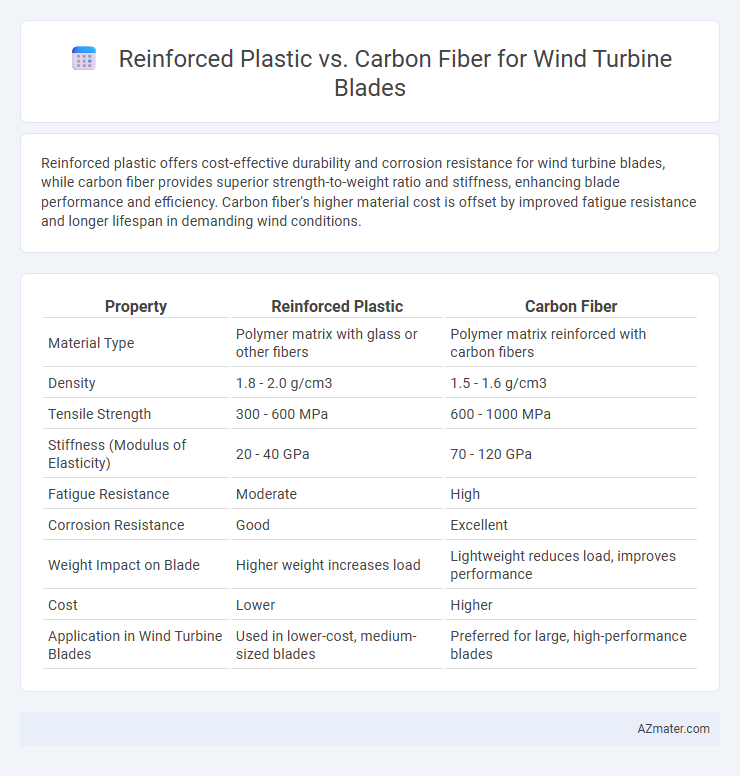Reinforced plastic offers cost-effective durability and corrosion resistance for wind turbine blades, while carbon fiber provides superior strength-to-weight ratio and stiffness, enhancing blade performance and efficiency. Carbon fiber's higher material cost is offset by improved fatigue resistance and longer lifespan in demanding wind conditions.
Table of Comparison
| Property | Reinforced Plastic | Carbon Fiber |
|---|---|---|
| Material Type | Polymer matrix with glass or other fibers | Polymer matrix reinforced with carbon fibers |
| Density | 1.8 - 2.0 g/cm3 | 1.5 - 1.6 g/cm3 |
| Tensile Strength | 300 - 600 MPa | 600 - 1000 MPa |
| Stiffness (Modulus of Elasticity) | 20 - 40 GPa | 70 - 120 GPa |
| Fatigue Resistance | Moderate | High |
| Corrosion Resistance | Good | Excellent |
| Weight Impact on Blade | Higher weight increases load | Lightweight reduces load, improves performance |
| Cost | Lower | Higher |
| Application in Wind Turbine Blades | Used in lower-cost, medium-sized blades | Preferred for large, high-performance blades |
Introduction to Wind Turbine Blade Materials
Wind turbine blades require materials that combine high strength, low weight, and durability to withstand harsh environmental conditions. Reinforced plastics, typically fiberglass composites, offer cost-effective manufacturing and good fatigue resistance but have lower stiffness-to-weight ratios compared to carbon fiber composites. Carbon fiber materials provide superior mechanical properties, including higher tensile strength and stiffness, enabling longer blade designs for improved energy capture and efficiency in modern wind turbines.
Overview of Reinforced Plastics
Reinforced plastics, commonly composed of a polymer matrix combined with glass or carbon fibers, offer high strength-to-weight ratios and excellent corrosion resistance, making them suitable for wind turbine blades. These materials provide flexibility in design, ease of fabrication, and cost efficiency compared to traditional materials, contributing to longer blade life and reduced maintenance. Their fatigue resistance and ability to withstand harsh environmental conditions are critical for the durability and performance of wind turbine blades in various wind regimes.
What is Carbon Fiber?
Carbon fiber is a lightweight, high-strength material composed of thin, crystalline filaments of carbon tightly woven into fabric and embedded in a polymer resin, providing exceptional stiffness and durability. In wind turbine blades, carbon fiber offers superior structural performance and fatigue resistance compared to reinforced plastics, enabling longer blade spans and enhanced energy capture. Its higher cost is balanced by increased efficiency and reduced material weight, making it a preferred choice for cutting-edge turbine designs.
Strength and Durability Comparison
Carbon fiber offers superior strength-to-weight ratio compared to reinforced plastic, making it more effective in withstanding high stress and fatigue in wind turbine blades. Reinforced plastics exhibit good corrosion resistance and impact tolerance, but carbon fiber provides enhanced stiffness and long-term durability under cyclic loading conditions. The use of carbon fiber composites results in longer blade lifespan and reduced maintenance costs due to their superior fatigue resistance and structural integrity.
Weight and Structural Efficiency
Carbon fiber offers superior weight reduction and higher structural efficiency compared to reinforced plastic in wind turbine blades, enabling longer blade lengths and improved energy capture. Reinforced plastics, while more cost-effective, generally exhibit higher density and lower stiffness-to-weight ratios, limiting blade performance and durability under cyclic loading. The enhanced strength-to-weight ratio of carbon fiber supports lighter, stiffer blades that can withstand extreme wind conditions, optimizing turbine efficiency and lifespan.
Cost Analysis: Reinforced Plastic vs Carbon Fiber
Reinforced plastic offers a lower initial material cost compared to carbon fiber, making it a more budget-friendly option for wind turbine blade manufacturing. Carbon fiber's high strength-to-weight ratio leads to enhanced performance and longer lifespan, potentially reducing maintenance and replacement costs over time. Evaluating the total cost of ownership involves balancing the upfront savings of reinforced plastic against the durability and efficiency benefits of carbon fiber in wind energy applications.
Manufacturing and Scalability
Reinforced plastics offer cost-effective manufacturing with simpler processing techniques like injection molding and are more scalable for large-volume wind turbine blade production due to lower material expenses. Carbon fiber provides superior strength-to-weight ratios and enhanced fatigue resistance but requires energy-intensive, complex manufacturing processes such as resin transfer molding, limiting scalability for mass production. The trade-off between manufacturing complexity and scalability makes reinforced plastics more viable for large-scale applications, while carbon fiber suits high-performance, specialized turbine blades.
Environmental Impact and Sustainability
Reinforced plastic wind turbine blades typically have higher environmental impacts due to their reliance on non-recyclable thermoset resins and energy-intensive manufacturing processes, leading to greater carbon footprints and landfill waste. Carbon fiber composites, despite their higher initial energy use, offer enhanced durability and recyclability potential, contributing to longer blade lifespans and reduced lifecycle environmental burdens. Innovations in carbon fiber recycling technology and bio-based resins are improving sustainability prospects, making carbon fiber increasingly favorable for eco-friendly wind turbine blade production.
Performance in Harsh Weather Conditions
Reinforced plastic offers durability and cost-effectiveness in wind turbine blades but tends to degrade under extreme weather conditions such as heavy rain, ice accumulation, and high UV exposure. Carbon fiber provides superior strength-to-weight ratio and excellent resistance to fatigue and corrosion, maintaining performance stability in harsh environments like strong winds and temperature fluctuations. The enhanced stiffness and long-term endurance of carbon fiber blades result in improved energy efficiency and reduced maintenance needs compared to traditional reinforced plastic materials.
Future Trends in Wind Turbine Blade Materials
Future trends in wind turbine blade materials emphasize the shift from traditional reinforced plastics to advanced carbon fiber composites, driven by the need for lighter, stronger, and more fatigue-resistant blades. Carbon fiber's superior strength-to-weight ratio enhances turbine efficiency and enables longer blades, reducing energy costs and improving performance in low-wind environments. Innovations in hybrid composites and recycled carbon fiber materials are also emerging, promoting sustainability and cost-effectiveness in next-generation wind turbine blade manufacturing.

Infographic: Reinforced plastic vs Carbon fiber for Wind Turbine Blade
 azmater.com
azmater.com